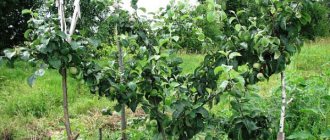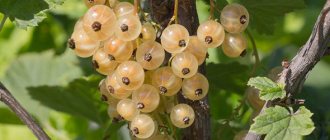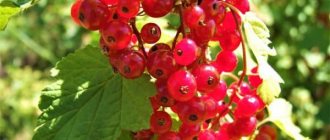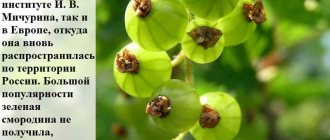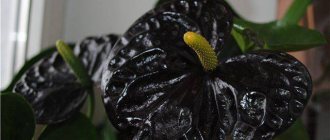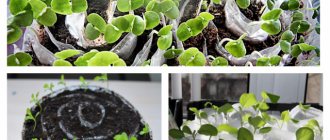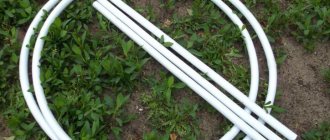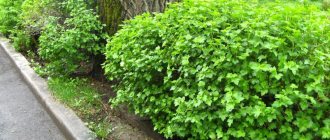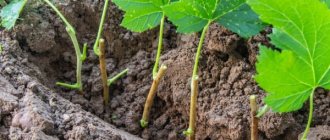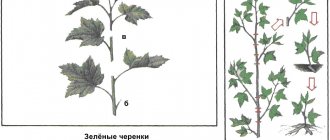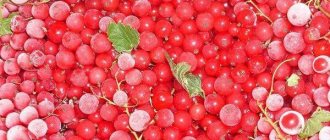Why do you need supports for currants?
Support is needed for proper formation of the bush. Thanks to the support, the plant takes up less space on the site, and it is easier for gardeners to harvest. The shrub is more well-groomed; the branches do not fall down or sag under the weight of ripe fruits.
It is also easier for summer residents to work with the soil: water, fertilize, loosen and mulch. In winter, covering material is fixed to the fences, which protects the bushes from gusty winds and frosts.
If currants grow without supports, the branches lie on the ground, and the fruits come into contact with the ground, which causes diseases. If the ground is wet, the berries become covered with plaque, mold or rot. When caring for shrubs, you have to lift the shoots yourself with one hand - this is inconvenient.
The structure of a currant bush
It is very easy to determine the age of a currant branch by the color of the bark (the older the shoot, the darker the bark):
- Zero age - young, green, not yet lignified shoots growing from the center of the bush in the summer.
- Annuals are the lightest (almost white, light yellow or olive), without lateral branches.
- Two-year-olds - branches with bright brown bark and side shoots.
- Three-year-old shoots are thick and dark, highly branched.
- Four-year-olds and older have cracked, ash-black bark, often covered in moss or lichen.
Each currant bush consists of branches of different ages: the lightest ones are annual ones, and the darkest ones are three years old and older.
In turn, each branch in the second and subsequent years is overgrown with annual growths (they differ from the main one in color). The size of the increments can be used to judge the productivity of the branch: the longer they are, the more berries there will be. In healthy and productive currants, annual growths can reach a length of 80 cm.
If they are short, it means the bush is growing in the shade or it lacks nutrition.
The currant bush should consist of 10–15 shoots of different ages:
- 4–6 annuals;
- 4–6 two year olds;
- 2-3 three year olds.
Of the zero shoots that grow in the summer, you should also leave 4–6 of the strongest ones.
Correctly formed bush: sparse, there are branches of all ages, old ones are cut into vertical shoots, have good growth
Advantages and disadvantages
The supports are functional: they are safe for the plant, simplify harvesting and maintenance, and promote ventilation of the root system. They are stable, lightweight, and easy to install. If the garden plot is decorated in a certain style, the supports serve as a decorative element.
Supports harm the plant only if the structure is tight and prevents the currants from developing. Also dangerous for currants are fences installed with technological violations, for example, weakly stable or with an excessive height.
How to make props with your own hands
Gardeners make supports for currants from wooden pegs, PVC pipes, branches or metal. To do this, prepare tools and take measurements.
From wooden pegs
Wood is a reliable, environmentally friendly and practical material; besides, in every household there are unnecessary boards.
The above-ground part of such a structure must be at least 50 cm. In order for the support to withstand winds, it is buried 40 cm. To make a support from wooden pegs, in addition to boards, you will need self-tapping screws, a screwdriver, and a hammer.
Manufacturing instructions:
- Make a mark of 70-80 cm on a board or beam.
- Cut 4 supports.
- Drive them around the currant bush in the shape of a square.
- Cut 4 thin boards from the timber.
- Attach them using self-tapping screws to the supports.
From the branches
Branch supports are the simplest design. To make it, you need a narrow strip, 4 branches 75 cm long, self-tapping screws, a screwdriver and a hammer. Gardeners drive branches around the perimeter of the bush, then secure the planks to them with self-tapping screws on pegs. This procedure takes no more than an hour. However, supports made from branches are short-lived and last no more than one season.
Attention! From branches you can make a structure on two legs. This support looks like a bracket and supports only one part of the berry bush.
Made from PVC pipes
PVC pipes are more expensive compared to wooden pegs and branches, but such structures last a long time and are functional. The pipes consist of two layers of polyvinyl chloride, between which an aluminum pipe is placed. The supports do not break in the wind and hold any covering material. The outer layer of PVC pipes is not afraid of rain and snow and is resistant to rotting.
To make a support, you need a fiberglass pipe 4 m long, a wire with a diameter of 5 mm, a hammer and a knife.
Manufacturing process:
- Cut the PVC pipe so that you get 4 supports 75 cm long.
- Make through holes in each.
- Place supports around the currants.
- Pass the wire through the holes.
- Use construction adhesive to secure parts.
Made of metal
Metal fencing is the most reliable and durable. They are not afraid of any weather conditions. The metal can support plants of any size and weight and is protected from corrosion.
The disadvantage is the complexity of manufacturing and heavy weight. To create the structure you will need a metal pipe and wire, as well as a hammer, grinder and pliers.
What to do:
- 4 supports 75 cm long are cut from the pipe.
- One through hole is made in each.
- Drive supports around the perimeter of the plant.
- Pull the metal wire through the holes and tighten firmly.
- To protect against moisture, the holes are plugged with plugs.
- Cover the support with protective paint - it will prevent corrosion.
From a metal rod
A metal rod is a thin rod. To make a support, it is bent in half around the tree to form an arc.
The rod is placed in the ground to a depth of 50 cm, and the rod should support the currant branches. The design is durable and easy to manufacture.
From lawn lamps
To create an original support, use non-working lawn lights. They are disassembled, the upper part of the lampshade is removed and installed around the perimeter of the bush. If the height of the lanterns is small, branches or wooden stakes are tied to them.
A cord or wire is attached to each support, on which currant branches are laid. The advantage of the support is that lawn lights, thanks to their sharp base, can be easily driven into the ground.
This is interesting:
How to grow purple roses and which varieties to choose
Why are black currants black?
Varieties and independent production of trellises for grapes
Quick fencing methods
To fence the best varieties of blackcurrant, you can use various elements from old and unnecessary household items. This is how an old bicycle rim without spokes can become the basis of a fence. To do this, several vertical supports are dug around the bush, to which the wheel rim is attached. An old chair without a seat or a broken stool is good for fencing berry bushes. Very often, old car tires become an element of garden design. They can be cut into several rings, which can be easily mounted on vertical supports. This article will tell you about Dutch varieties of tomatoes.
Selection and purchase of ready-made bush holders
When choosing a ready-made bush holder, pay attention to the shape, size, and color. For young and compact bushes, round supports with 2-3 legs are suitable, for mature and branched plants - square ones with 4 supports. Wooden supports are attractive due to their low price, but they only last 1-2 years. The shelf life of metal ones is about 5 years, because after that they undergo corrosion and lose their appearance and functionality.
Plastic supports have no such restrictions - they are lightweight, affordable, and durable.
For berry bushes, it is better to buy collapsible bush holders than monolithic ones. In the first case, it is easier to choose the size and shape for a specific bush. In addition, the plant is constantly changing - it is impossible to predict what it will be like in 2-3 years. When purchasing, make sure that there are no cracks or scratches on the supports.
Buy stands for bushes
Stands and fences for bushes are presented in a wide variety, and these practical products are in good demand.
Metal fencing for bushes
Made from powder coated steel. Can be of various colors and configurations. Forged metal fences look especially beautiful.
Welded metal fences are the strongest and have a number of advantages:
- presentable appearance;
- anti-corrosion protection;
- high stability and ability to withstand heavy loads;
- easy DIY assembly;
- metal products do not need to be removed for the winter;
- durability.
You can buy a bush holder made of steel from 350 rubles. Forged metal stands will cost much more.
Plastic stands for shrubs
Plastic fencing has a favorable price and a large selection depending on the purpose: “currant”, “cascade”, “peony”, “rose”, “pyramid” and others.
Plastic fencing is easy to install and easy to disassemble and assemble.
The advantages of plastic bush holders are as follows:
- aesthetic appearance;
- easy and quick assembly;
- light weight;
- good strength and rigidity;
- versatility - suitable for different shrubs;
- can be used many times.
The cost of plastic bush holders varies from 140 to 300 rubles. When choosing a stand for bushes, the following design features of the product should be taken into account:
- Shape of bush holder. The upper element supporting the branches can be made in the form of a circle, semicircle, or square. Here you can focus on your own preferences and the shape of the bush.
- Number of support legs. The support posts for the fence can be from 2 to 4. A larger number of supports makes the structure more rigid and durable.
- Disassembly or integrity of the product. It is often very difficult to put a solid stand on a dense bush; in such cases, it is better to use collapsible options.
As a result, we can advise you to choose collapsible, metal options on four supports for spreading heavy bushes. For bushes that grow again in the spring, for example, peonies, plastic holders of a non-demountable design are suitable.
How to strengthen currants with supports yourself
Proper currant garter protects the plant from diseases and pests and makes it easier to care for the bush throughout the growing season. Tied fruits are better illuminated by sunlight and grow larger and more appetizing.
Currants are tied up in the third year after planting. During this period, the height of the plant reaches 1.5 m, and the first harvest is formed on the shoots. There is no point in tying up the bush before.
Required materials and tools
Easy to use plastic clips or clothespins . They are sold at any gardening store and look similar to clothespins. They are inexpensive, take up little space, and are suitable for repeated use. However, they can only be used for attaching currants to thin supports.
For large and thick supports, special garter belts are used. They have fasteners. With their help, the belt can be easily tightened on structures of any diameter. These can be thin metal pipes or massive wooden stakes. Garden belts have been used for many years.
Possible schemes
In addition to tying a currant bush onto a single frame, gardeners use tying schemes for trellises, pipe supports, and a triangle:
- A series of metal or wooden stakes 80 cm high are driven in near the currants. A wire or rope is hooked between them, and currant branches are tied to it. Gartering on trellises is relevant for those who grow 5 or more bushes in one row on a plot.
- To tie currants to pipes, install 2, 3 or 4 pipes around the perimeter of the bush. This design is very similar to a single frame garter.
- An equilateral triangle is built around the currant from 3 stakes. The plant is tied to each side using clothespins or belts. The triangle is an original way of gartering; it looks unusual, especially if you use multi-colored stakes instead of plain ones.
Features of fencing front gardens and flower beds
A front garden is a local area enclosed by a low fence. As a rule, a front garden is arranged in front of the house and the road for planting ornamental plants.
The open front garden has no fencing and consists of flower beds, low bushes and a lawn. The closed palisade is fenced around the perimeter of the site with a fence, the height and design of which is selected according to the exterior of the building.
In most cases, the following materials are used to make front garden fencing:
- tree - picket fence. The width and height of the board depends on the personal preferences of the owner. Usually a board of 1–1.5 m is used, which is mounted on transverse guides fixed to a concreted metal pole;
- metal - forged fence with patterns. It consists of ready-made sections that are attached to brickwork or metal poles. It has a high cost due to the high labor costs for their production.
Stone and metal fences without gaps are used quite rarely, as they do not provide plants with enough sunlight, blocking its penetration through the fence.
In some cases, it is possible to install a hedge. These are plants with a dense crown that are planted close to each other. As they grow, they are pruned to form the desired density and shape of the crown. The result is a beautiful hedge of living plants.
The same rules apply for fencing separately located flower beds. The fence should be visually attractive and allow sufficient light to pass through without shading plants and flowers. For flower beds located in fenced areas, it is not necessary to use additional fencing. It is enough to equip a low supporting structure for tall flowers. Small flower beds are fenced with a box made from scrap materials or finished products like decorative borders.
Nuances of fencing grapes
In the central zone, where the average summer temperature is noticeably lower, trellises are used for comfortable growth and fruiting. These are vertical support structures made of various materials. The shape of the trellis is selected depending on the planting pattern and grape variety.
When making trellises yourself, it is better to use high-quality materials, since this is a massive structure, which is not rational to change every season. Especially if a person is engaged in growing grapes on an ongoing basis.
Advice from experienced gardeners
In order to properly fence currants and buy the necessary stands, experienced gardeners recommend first of all paying attention to the material of manufacture . Be sure to take into account the size and age of the bush. If there are several plants, buy a special structure that makes it easy to tie up 2 or more bushes.
Install the support at a depth of 50 cm so that it is stable. If the fence is metal, check it regularly for corrosion; if it is wooden, check it for mold and traces of rot. If such signs are detected, the fences are replaced with new ones.
Mistakes to Avoid
A common mistake is using strips of natural or synthetic fabrics for support. They pull the shoots and break them, so it is better to use special clothespins or belts.
Also, newbie gardeners think that they need to tie up currants 1-2 times. But this is not so: the plant is constantly developing, which means it needs to be tied up regularly, as the shoots grow.
Attention! Do not pull the branches too tightly. This leads to the branches drying out and losing the entire harvest. It is impossible to restore such shoots.
Mistake 4. You don't trim the currants
Fearing mistakes when pruning, many gardeners leave currant bushes untouched. As a result, they become very thick, overgrown with old unproductive branches that shade young fruit-bearing shoots, as well as with tops - powerful, unproductive shoots inclined to the ground. Such plants produce a very poor harvest and often get sick.
What to do?
For black currants, immediately after planting, shorten all branches to 2-4 well-developed buds. In the fall of next year, leave only 3-4 of the strongest and most well-developed shoots in the bush. Cut all the rest close to the ground. In each subsequent year, prune the currants according to the same principle - from all the shoots that grew over the summer, select the 3-4 strongest ones and shorten them for better branching, and remove all the rest. After 4-5 years, you will have a fully formed bush with 15-18 branches of different ages.
Subsequent pruning of blackcurrant bushes comes down to removing branches older than 5-6 years of age (they are the thickest and most branched) and replacing them with the same number of well-developed “first-years”.
Red and white currants do not form as many shoots as black currants, and their branches retain their “working capacity” for 7-8 years. Therefore, the principle of pruning these bushes is different. In the first years, only sanitary pruning is carried out, removing all diseased, broken and thickening shoots of the bush.
In red currants, the largest number of berries are formed on the tops of the shoots. Therefore, under no circumstances should they be cut or pinched - by doing this you will deprive yourself of a significant part of the harvest.
From 5-8 years of age, begin to remove old unproductive branches that have produced few berries or did not bear fruit at all during the season. On average, to obtain a good harvest of large berries, a red (white, pink) currant bush should have 10-12 branches of different ages.
